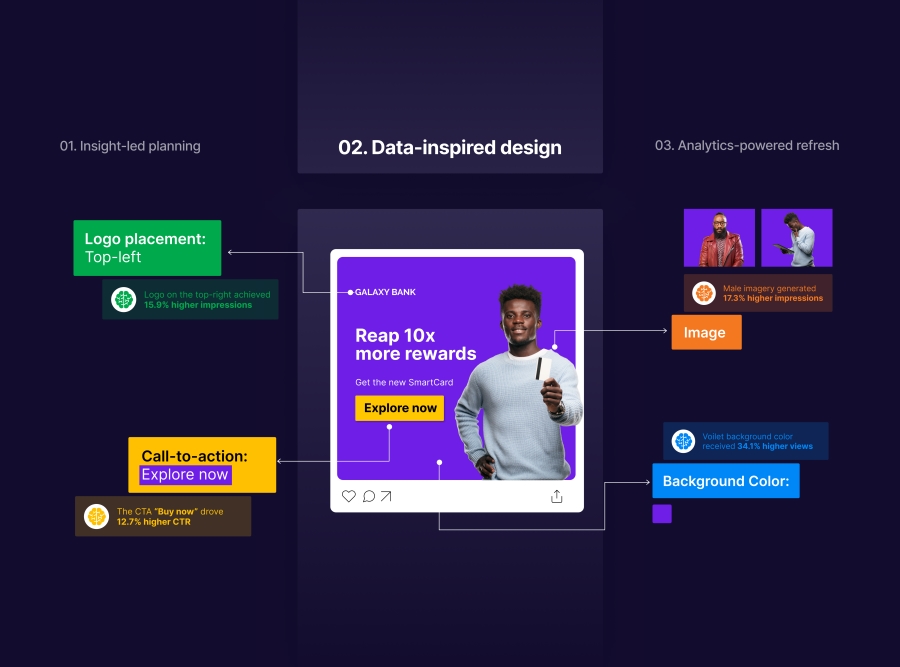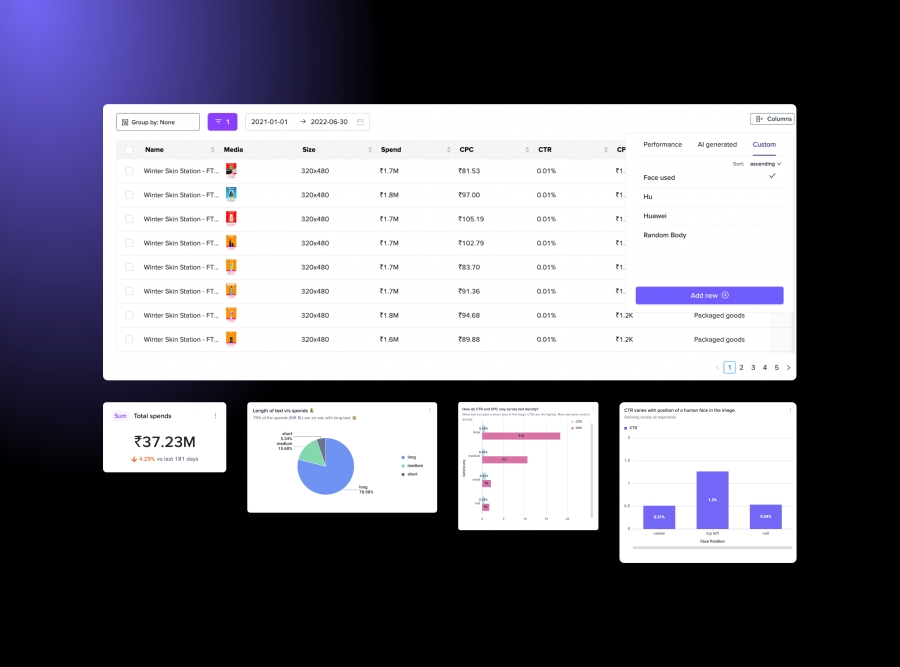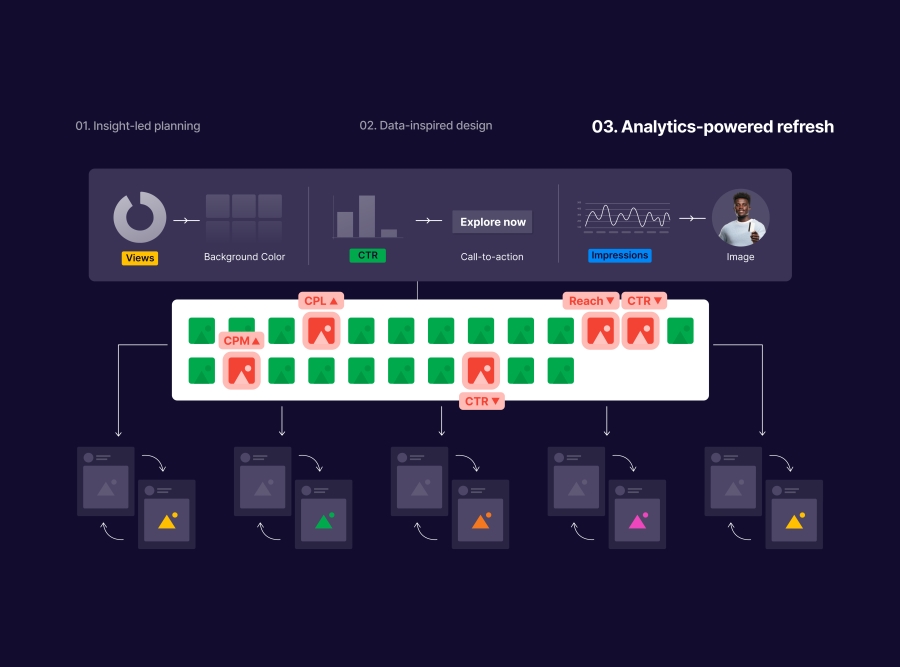

Advertising campaigns are largely grounded in data, right from planning to execution and performance analysis. But your audiences don’t look at “campaigns”, they see visuals and creatives that essentially form the face of an ad campaign. And much of these visuals have been data-dark for the longest time, with meager insights into what creative elements work or don’t work. Marketers and designers have mostly depended on intuition to create visuals – which isn’t a bad thing, but intuition without data-backed insights doesn’t yield great results.
Today’s digital arms race requires marketers to understand how visuals impact campaign performance, especially when large numbers of products or services are advertised to large, diversified cohorts. With only 8 seconds to grab the attention of target audiences, brand creatives need to stand out – they need to be crafted using powerful data on past campaigns, competitor intelligence, industry trends and more.
What seemed like a nice-to-have a few years ago, is now key to ensuring maximum ROAS while staying ahead of competition. A study by McKinsey found that marketers who unite data and creativity see 2x revenue growth. But how can your brand seamlessly integrate analytics into your entire creative operations?
Currently, everything we know about creative performance is post-facto, which is after the campaign is done and dusted. There’s a lack of insight into how creative elements impact performance of the campaign both before the campaign starts, and also during the time it’s live. Given that performance data is scattered across multiple platforms such as Google, Meta, and other ad exchange networks, the time it takes to manually collate all the data and identify any dip in performance is too long. Consequently, creative delay occurs across many campaigns by the time your team refreshes them (sometimes the wrong ones even).

Making sense of creative impact on performance after the campaign ends is also a challenge given the siloed nature of data and its disconnect with the creative production process. This unscientific creative decisioning can lead to a huge waste in ad budgets which could easily be prevented with a centralized layer of creative intelligence.
Things get even murkier when it comes to mapping specific creative elements to performance metrics like CPA, CPM and CTR. The insights drawn from campaigns have no way of attributing performance to creative decisions, so both your creative refresh and planning for the next campaign are intuition based and at best, have a 50/50 chance of success.
A new cookie-less digital world now demands deterministic data that ties together every customer touchpoint. Creative analytics helps remove the expense of uncertainty – by connecting every design choice to a performance metric, which in turn impacts revenue, time, and cost savings.

Businesses can now ride on the back of an agile CreativeOps platform like Rocketium to create a single-source-of-truth for all creative data. First, campaign performance data is synced from all your advertising channels like social media and ads, the web, email and push – this is done at periodic intervals so that your dashboard is always updated with numbers that reflect the latest time-stamps. This centralized data now allows you to track every performance metric and match it to visual elements like background color, CTA, image and logo style.
Now combine such powerful cross-platform, creative-level performance data with competitor intelligence easily available on your analytics dashboard, and you’re all set to deterministically plan, create and optimize creatives in real-time.

A struggle that most marketing teams are familiar with: mining creative insights has largely been a probabilistic process involving outrageous amounts of money and time, all leading to mere… prototypes. This doesn’t help advertisers understand how specific creative decisions lead to certain outcomes and much of ad spends are bled out with poor returns.
But tech-driven analytics helps clear the fog of creative planning by powerfully combining your own creative performance data with competitor intelligence, enabling you to understand what visual elements work best for your industry.
Creative performance data from past campaigns are now easily accessible in one place. Brands can integrate data from their digitals channels of choice, and automatically pull data that enriches performance insights. Moreover, this data can be organized efficiently with role-based access, enabling better collaboration while filtering the right content for the right person. Alongside your own creative insights, competitor intelligence adds a winning advantage to your visuals and helps you stay one step ahead of the market. For example, if you know that your biggest competitor is using a specific kind of CTA content, you can plan to experiment with something similar for your own creatives.

Even the biggest global companies are starting to discover the importance of insight-led creative planning, and the impact is changing the way they allocate millions of marketing budgets. For the longest time, the world’s second-largest telecom company used zero performance insights and instead relied on instinct for their creative planning, despite more than 50% of their marketing budgets going to digital. They could only access campaign performance data from advertising platforms, while internal tools mostly proved inadequate and were quickly abandoned by teams.
With creative analytics, the brand was able to dive into creative insights, and found that their best performing propositions had the lowest amounts of budgets allotted! This helped them course-correct and save ad budgets by 20%, and optimize performance with 16% reduction in CPM. Download the full case study here.

Many large enterprises outsource their creative requirements to agencies to meet the volume and quality of output needed for campaigns, but the result is often poor performance outcomes made worse by stretched timelines, siloed and broken communication processes, all resulting in huge costs incurred by the enterprise.
The solution for effective design is empowering designers to integrate data-backed insights into every creative decision. Sometimes insights exist, but are not easily accessible for teams to use. Here’s where an analytics-first CreativeOps platform closes the gap and makes it seamless for designers to make data-inspired creatives:
In-editor recommendations are activated to make pointed suggestions to improve creatives based on past campaign insights and competitor intelligence. This helps shape important decisions that impact performance on the creative canvas itself, without needing any extra effort from designers.

Additionally, design heads now have a full picture of how creatives are performing, with AI filters that can find exactly what you need. Moreover, you can define and measure performance against specific visual elements such as CTA position, image color, font size and so on. Visualizing data is made easy with dynamic widgets that pull up data in the form of pie charts, bar graphs and line charts.

The world’s fifth largest pharmaceutical company struggled to create impactful designs and ended up with text-only posts which got poor engagement. Marketers didn’t have sufficient creative insights to make their visuals personalized and localized. Moreover, they had to work with multiple agencies to get content which meant delays, cost overruns and lost opportunities.
But the brand turned to an analytics-integrated automated design system, enabling them to create powerful visuals in local languages with advanced insights integrated into the creative process. This led to a whopping 95% decrease in campaign go-live time and their creatives saw 4.8x higher engagement compared to previous ones. Download the full case study here.

The world of digital advertising is so cluttered and competitive that the average brand has just 8 seconds to grab their audience’s attention, so every visual put out there has to be relevant and fresh. Brands need to ensure creative refresh every few weeks, but the question is what do they change to optimize their campaign performance?
A centralized creative performance dashboard can now give marketers and designers an eagle-eye view into how every visual element impacts performance metrics. Teams can always stay on top of ongoing campaigns with automatic alerts that detect decaying creatives. This way, you can immediately identify and replace poor performing ads without wasting any time. Moreover, custom reports are automatically generated at regular intervals to align stakeholders and add credibility to your projects without the pain of pulling out endless excel sheets.

The world’s largest eCommerce platform lacked the infrastructure to identify poor-performing creatives on time and couldn’t help brand advertisers refresh them before their campaigns slumped. Website banners with out-of-stock products or prices higher than the competition were seeing low click-through rates.
But the platform went on to adopt a self-service creativeOps technology which enabled advertisers to access automated insights with performance best practices. This helped them execute 5x faster creative refreshes in real-time and helped them save 40% of budgets during sale. Download the full case study here.
Having a centralized creative intelligence layer is the answer to getting your visual communication right – so why wait?
At Rocketium, we can support your entire CreativeOps journey with tech-enabled analytics and design experts. This way, you can access advanced creative insights without needing to worry about new software adoption and the hassles of changing team behavior. You merely hand over briefs and wait for impactful results, our experts ensure the rest is done.
Another way to do this is by onboarding your studios, business teams, or external partners on our self-serve CreativeOps platform. Start with a single use-case such as automated brand-compliance or AI-driven design systems, or go all in with our full suite. This way you control the nuances of how your teams can tap into creative insights to plan and execute visuals.
If you’re interested to discuss to learn more about reach out to us on success@rocketium.com.